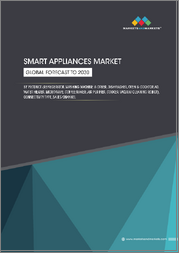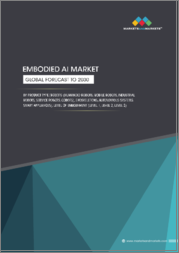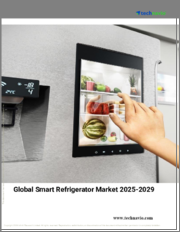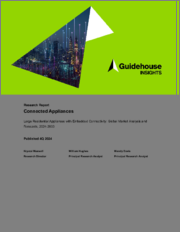
|
시장보고서
상품코드
1666107
스마트 냉장고 시장 규모, 점유율, 성장 분석 : 도어 유형별, 유통 채널별, 최종사용자별, 지역별 - 산업 예측(2025-2032년)Smart Refrigerator Market Size, Share, and Growth Analysis, By Door Type (Single, Double), By Distribution Channel (Offline, Hypermarket/Supermarket), By End User, By Region - Industry Forecast 2025-2032 |
||||||
스마트 냉장고 시장 규모는 2023년 36억 달러로 평가되며, 2024년 38억 8,000만 달러에서 2032년 70억 8,000만 달러로 예측 기간(2025-2032년) 동안 7.8%의 CAGR로 성장할 것으로 예상됩니다.
세계 스마트 냉장고 시장은 스마트홈 기술 및 에코시스템의 채택 확대로 인해 성장이 예상됩니다. 가처분 소득의 증가와 스마트 기기에 대한 투자 의지가 공급업체들에게 새로운 기회를 제공하고 있습니다. 에너지 효율에 대한 관심과 스마트 기능의 혁신이 시장 성장을 더욱 촉진하고 있습니다. 도시화와 편의성에 대한 소비자의 선호도가 높아지면서 수요가 증가할 것으로 예상됩니다. 인공지능, 사물인터넷, 머신러닝의 발전은 새로운 스마트 냉장고의 개발로 이어지고 있습니다. 그러나 높은 초기 비용, 데이터 프라이버시 문제, 개발도상국의 인터넷 연결 부족, 기능의 복잡성 등의 문제는 당분간 공급업체들이 시장 상황을 효과적으로 헤쳐나가는 데 걸림돌이 될 수 있습니다.
목차
소개
- 조사 목적
- 조사 범위
- 정의
조사 방법
- 정보 조달
- 2차와 1차 데이터 방법
- 시장 규모 예측
- 시장 가정과 제한
주요 요약
- 세계 시장 전망
- 공급과 수요 동향 분석
- 부문별 기회 분석
시장 역학과 전망
- 시장 개요
- 시장 규모
- 시장 역학
- 성장 촉진요인과 기회
- 성장 억제요인과 과제
- Porters 분석
주요 시장 인사이트
- 핵심성공요인
- 경쟁 정도
- 주요 투자 기회
- 시장 생태계
- 시장 매력 지수(2024년)
- PESTEL 분석
- 거시경제 지표
- 밸류체인 분석
- 가격 분석
- 규제 상황
- 사례 연구
- 기술의 진보
스마트 냉장고 시장 규모 : 도어 유형별
- 시장 개요
- 싱글 도어
- 더블 도어
- 사이드 바이 사이드
- 프렌치 도어
스마트 냉장고 시장 규모 : 유통 채널별
- 시장 개요
- 오프라인
- 하이퍼마켓/슈퍼마켓
- 전문점
- 온라인 소매
스마트 냉장고 시장 규모 : 최종사용자별
- 시장 개요
- 주거용
- 상업용
스마트 냉장고 시장 규모
- 북미
- 미국
- 캐나다
- 유럽
- 독일
- 스페인
- 프랑스
- 영국
- 이탈리아
- 기타 유럽
- 아시아태평양
- 중국
- 인도
- 일본
- 한국
- 기타 아시아태평양
- 라틴아메리카
- 브라질
- 기타 라틴아메리카
- 중동 및 아프리카
- GCC 국가
- 남아프리카공화국
- 기타 중동 및 아프리카
경쟁 정보
- 상위 5개사의 비교
- 주요 기업의 시장 포지셔닝(2024년)
- 주요 시장 기업이 채용한 전략
- 최근의 시장 동향
- 기업의 시장 점유율 분석(2024년)
- 주요 기업 개요
- 기업 상세
- 제품 포트폴리오 분석
- 기업 부문별 점유율 분석
- 매출 전년비 비교(2022-2024년)
주요 기업 개요
- Samsung Electronics(South Korea)
- LG Electronics(South Korea)
- Whirlpool Corporation(USA)
- Electrolux AB(Sweden)
- Panasonic Corporation(Japan)
- Midea Group(China)
- Hisense(China)
- Arcelik A.S.(Turkey)
- BSH Hausgerate GmbH(Germany)
- Sub-Zero Group, Inc.(USA)
- Liebherr Group(Germany)
- SMEG S.p.A.(Italy)
- Godrej Appliances(India)
- Haier Group Corporation(China)
- GE Appliances(USA)(Parent company : Haier Group Corporation)
- Fisher & Paykel(New Zealand)(Parent company : Haier Group Corporation)
- Daewoo Electronics(South Korea)
- Hitachi Appliances(Japan)
- Toshiba Lifestyle Products & Services Corporation(Japan)
- Vestel(Turkey)
결론과 제안
ksm 25.04.03Smart Refrigerator Market size was valued at USD 3.6 billion in 2023 and is poised to grow from USD 3.88 billion in 2024 to USD 7.08 billion by 2032, growing at a CAGR of 7.8% during the forecast period (2025-2032).
The global smart refrigerator market is expected to thrive due to the growing adoption of smart home technologies and ecosystems. Increasing disposable incomes and a willingness to invest in smart devices are creating new opportunities for suppliers. Emphasis on energy efficiency and innovations in smart features are further propelling market growth. Urbanization and a rising consumer preference for convenience are expected to boost demand. Advances in artificial intelligence, the Internet of Things, and machine learning are leading to the development of novel smart refrigerators. However, challenges such as high initial costs, data privacy concerns, inadequate internet connectivity in developing regions, and the complexity of features may hinder vendors in navigating the market landscape effectively in the foreseeable future.
Top-down and bottom-up approaches were used to estimate and validate the size of the Smart Refrigerator market and to estimate the size of various other dependent submarkets. The research methodology used to estimate the market size includes the following details: The key players in the market were identified through secondary research, and their market shares in the respective regions were determined through primary and secondary research. This entire procedure includes the study of the annual and financial reports of the top market players and extensive interviews for key insights from industry leaders such as CEOs, VPs, directors, and marketing executives. All percentage shares split, and breakdowns were determined using secondary sources and verified through Primary sources. All possible parameters that affect the markets covered in this research study have been accounted for, viewed in extensive detail, verified through primary research, and analyzed to get the final quantitative and qualitative data.
Smart Refrigerator Market Segments Analysis
Global Smart Refrigerator Market is segmented by Door Type, Distribution Channel, End User and region. Based on Door Type, the market is segmented into Single, Double, side by Side and French. Based on Distribution Channel, the market is segmented into Offline, Hypermarket/Supermarket, Specialty Stores and Online Retail. Based on End User, the market is segmented into Residential and Commercial. Based on region, the market is segmented into North America, Europe, Asia Pacific, Latin America and Middle East & Africa.
Driver of the Smart Refrigerator Market
The increasing trend of smart home technologies globally has significantly driven the adoption of connected appliances, particularly smart refrigerators. These advanced refrigerators offer seamless integration with various smart home systems, enhancing user experience through improved connectivity and convenience features. As more consumers embrace smart home ecosystems, the demand for smart refrigerators continues to rise, positively influencing the overall outlook of the global smart refrigerator market. The synergy between smart home gadgets and appliances contributes to a more efficient and user-friendly living environment, reinforcing the growing appeal and market potential for smart refrigerators worldwide.
Restraints in the Smart Refrigerator Market
While smart refrigerators boast impressive and innovative features, their complexity may pose challenges for consumers who are not well-versed in technology. The advanced functionalities could overwhelm certain users, leading to intimidation or, conversely, result in these features being underutilized. This potential disconnect between the product's capabilities and the consumers' ease of use could negatively impact the adoption and sales of smart refrigerators in the market. As a result, manufacturers may face obstacles in appealing to a broader audience, particularly those who may prefer simpler and more user-friendly appliances.
Market Trends of the Smart Refrigerator Market
The Smart Refrigerator market is witnessing a significant trend towards customization and modular design, driven by consumer demand for enhanced control and personalization of appliances. As manufacturers innovate, they are focusing on creating customizable compartments and convertible zones that allow users to tailor their refrigerator's functionality to meet specific needs. This flexibility not only enhances user experience but also integrates seamlessly into diverse kitchen layouts and lifestyles. Companies investing in these adaptive designs are poised to gain a competitive edge, aligning their products with the growing trend towards personalized technology in the home. This trend is expected to shape the market dynamics well into the future.
Table of Contents
Introduction
- Objectives of the Study
- Scope of the Report
- Definitions
Research Methodology
- Information Procurement
- Secondary & Primary Data Methods
- Market Size Estimation
- Market Assumptions & Limitations
Executive Summary
- Global Market Outlook
- Supply & Demand Trend Analysis
- Segmental Opportunity Analysis
Market Dynamics & Outlook
- Market Overview
- Market Size
- Market Dynamics
- Drivers & Opportunities
- Restraints & Challenges
- Porters Analysis
- Competitive rivalry
- Threat of substitute
- Bargaining power of buyers
- Threat of new entrants
- Bargaining power of suppliers
Key Market Insights
- Key Success Factors
- Degree of Competition
- Top Investment Pockets
- Market Ecosystem
- Market Attractiveness Index, 2024
- PESTEL Analysis
- Macro-Economic Indicators
- Value Chain Analysis
- Pricing Analysis
- Regulatory Landscape
- Case Studies
- Technological Advancement
Global Smart Refrigerator Market Size by Door Type & CAGR (2025-2032)
- Market Overview
- Single
- Double
- Side by Side
- French
Global Smart Refrigerator Market Size by Distribution Channel & CAGR (2025-2032)
- Market Overview
- Offline
- Hypermarket/Supermarket
- Specialty Stores
- Online Retail
Global Smart Refrigerator Market Size by End User & CAGR (2025-2032)
- Market Overview
- Residential
- Commercial
Global Smart Refrigerator Market Size & CAGR (2025-2032)
- North America (Door Type, Distribution Channel, End User)
- US
- Canada
- Europe (Door Type, Distribution Channel, End User)
- Germany
- Spain
- France
- UK
- Italy
- Rest of Europe
- Asia Pacific (Door Type, Distribution Channel, End User)
- China
- India
- Japan
- South Korea
- Rest of Asia-Pacific
- Latin America (Door Type, Distribution Channel, End User)
- Brazil
- Rest of Latin America
- Middle East & Africa (Door Type, Distribution Channel, End User)
- GCC Countries
- South Africa
- Rest of Middle East & Africa
Competitive Intelligence
- Top 5 Player Comparison
- Market Positioning of Key Players, 2024
- Strategies Adopted by Key Market Players
- Recent Developments in the Market
- Company Market Share Analysis, 2024
- Company Profiles of All Key Players
- Company Details
- Product Portfolio Analysis
- Company's Segmental Share Analysis
- Revenue Y-O-Y Comparison (2022-2024)
Key Company Profiles
- Samsung Electronics (South Korea)
- Company Overview
- Business Segment Overview
- Financial Updates
- Key Developments
- LG Electronics (South Korea)
- Company Overview
- Business Segment Overview
- Financial Updates
- Key Developments
- Whirlpool Corporation (USA)
- Company Overview
- Business Segment Overview
- Financial Updates
- Key Developments
- Electrolux AB (Sweden)
- Company Overview
- Business Segment Overview
- Financial Updates
- Key Developments
- Panasonic Corporation (Japan)
- Company Overview
- Business Segment Overview
- Financial Updates
- Key Developments
- Midea Group (China)
- Company Overview
- Business Segment Overview
- Financial Updates
- Key Developments
- Hisense (China)
- Company Overview
- Business Segment Overview
- Financial Updates
- Key Developments
- Arcelik A.S. (Turkey)
- Company Overview
- Business Segment Overview
- Financial Updates
- Key Developments
- BSH Hausgerate GmbH (Germany)
- Company Overview
- Business Segment Overview
- Financial Updates
- Key Developments
- Sub-Zero Group, Inc. (USA)
- Company Overview
- Business Segment Overview
- Financial Updates
- Key Developments
- Liebherr Group (Germany)
- Company Overview
- Business Segment Overview
- Financial Updates
- Key Developments
- SMEG S.p.A. (Italy)
- Company Overview
- Business Segment Overview
- Financial Updates
- Key Developments
- Godrej Appliances (India)
- Company Overview
- Business Segment Overview
- Financial Updates
- Key Developments
- Haier Group Corporation (China)
- Company Overview
- Business Segment Overview
- Financial Updates
- Key Developments
- GE Appliances (USA) (Parent company: Haier Group Corporation)
- Company Overview
- Business Segment Overview
- Financial Updates
- Key Developments
- Fisher & Paykel (New Zealand) (Parent company: Haier Group Corporation)
- Company Overview
- Business Segment Overview
- Financial Updates
- Key Developments
- Daewoo Electronics (South Korea)
- Company Overview
- Business Segment Overview
- Financial Updates
- Key Developments
- Hitachi Appliances (Japan)
- Company Overview
- Business Segment Overview
- Financial Updates
- Key Developments
- Toshiba Lifestyle Products & Services Corporation (Japan)
- Company Overview
- Business Segment Overview
- Financial Updates
- Key Developments
- Vestel (Turkey)
- Company Overview
- Business Segment Overview
- Financial Updates
- Key Developments



















